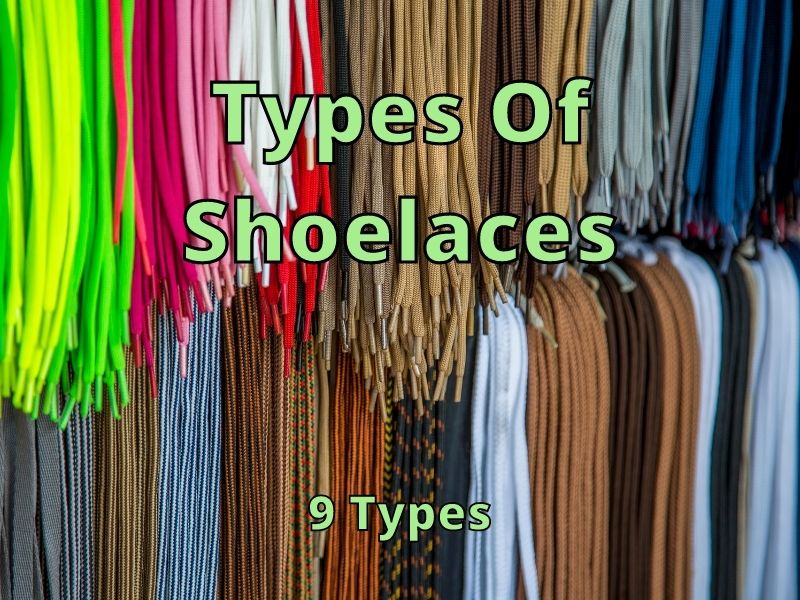All of us wear shoes, but shoelaces are often overlooked. Even though we tie them every day, do we know how many different types of shoelaces exist?
There are different types of shoelaces, including leather, cotton, nylon, polyester, elastic, etc. These shoelaces come with several features and are available in various colors, lengths, and widths. Here is the list of 9 types of shoelaces:
- Rawhide Shoelaces
- Flat Cotton Shoelaces
- Round Cotton Shoelaces
- Flat Waxed Shoelaces
- Nylon Shoelaces
- Textured Polyester Shoelaces
- Spun Polyester Shoelaces
- Elastic Shoelaces
- Paracord Shoelaces
The types of shoelaces you wear may vary depending on the materials used, their lengths, widths, colors, and the benefits and drawbacks. Let’s look at each one in more detail.
Rawhide Shoelaces

You have probably been familiar with rawhide laces since they have been around for years. You might even have some pairs of shoes with them.
Rawhide refers to leather that has not been tanned. However, unlike its name, rawhide shoelaces are made with regular, tanned leather and not actual rawhide.
Rawhide shoelaces are made from dairy cow leather, so they are strong and split-resistant. However, when rawhide shoelaces are dry, they are rigid and unsuitable for use. To use these shoelaces, you need to soak them in water for a few days, so they become soft.
Rawhide shoelaces mostly have 3.5mm width. And they are mostly paired with boat shoes and moccasins. These shoelaces are extremely durable but less than other leather shoelaces. So, you may find other better options in the market.
Although rawhide shoelaces will never break on you, unfortunately, they are tough to tie. Another drawback I see with these shoelaces is that you cannot tie them very close and tight to the shoe. As a result, their knots are loose and eventually come untied.
While these shoelaces are classic, durable, and look great with many outdoor shoes, they sometimes can become a hassle.
Benefits
- Rawhide shoelaces are pretty strong and slip-resistant.
- Rawhide shoelaces are highly durable and will never break on you.
- Rawhide laces are classic and look great with many shoes.
Drawbacks
- Using rawhide shoelaces at first can be a hassle since you need to soak them prior.
- Rawhide shoelaces are difficult to tie.
- You cannot tie these laces close to your shoes, so the knot is mostly loose and eventually come untied.
Flat Cotton Shoelaces
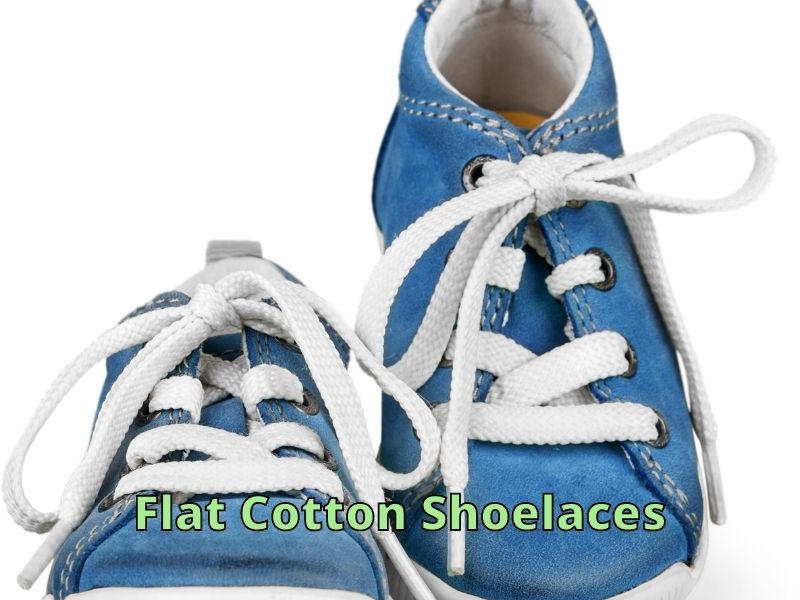
The cotton shoelace has been a standard for many years and is not uncommon for us. We all may have used these shoelaces at some point, but somehow, we replace them with other fancier shoelaces.
Cotton shoelaces are usually paired with tennis shoes and fashion shoes such as Keds, Chuck Taylors, and Vans. In addition, you can get cotton shoelaces in various colors like white, black, red, yellow, etc.
Most people prefer cotton shoelaces since they are easy to bind and have a firm grip. There are several benefits and drawbacks of cotton shoelaces; let’s see them:
Benefits
- Cotton shoelaces are cheap: so, if they become too dirty or ripped off, you don’t need to worry about spending a lot on a replacement pair of laces.
- Cotton laces are easy to clean: your sneakers can quickly get dirty. Pairing them with cotton laces would be a good idea since you can easily clean these laces [ you can read more: How to Clean Your Shoelaces]
- Cotton laces are easy to replace since they aren’t durable, so you might need to replace them often.
- Cotton laces are easily available, so you can easily find them in any shoe store.
- Compared to other laces, cotton laces are the most breathable.
- These laces are perfect for you if you like dry and smell-free feet.
Drawbacks
- Cotton laces are not durable and long-lasting.
- Cotton laces do not hold their shape like other laces.
- These shoelaces are more likely to trip and fall.
- You need to replace them often, especially if your shoes are well made and long-lasting.
- Cotton shoelaces are not as fancy as other types of laces, so you might get bored with them quickly.
Round Cotton Shoelaces
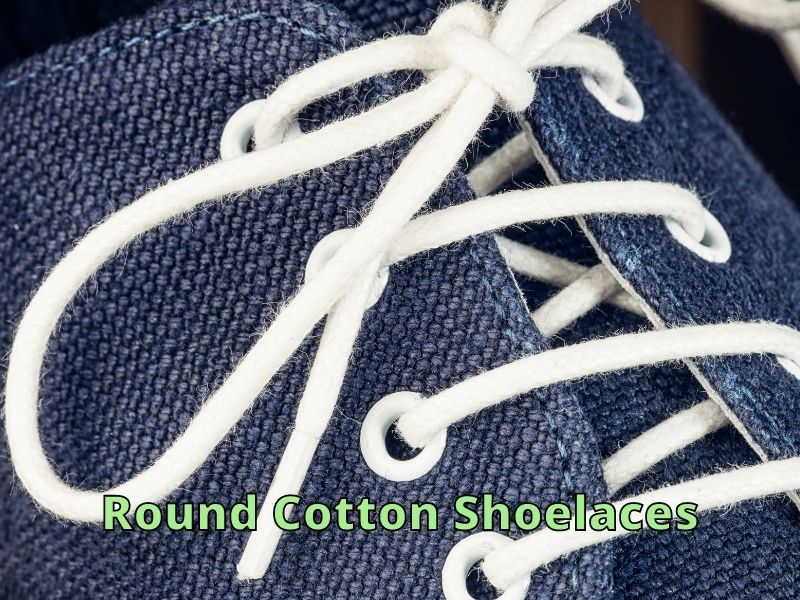
Cotton shoelaces are available in two different styles: flat and round. You can choose whichever suits you best. The difference between both styles doesn’t affect their performance, so you can pick whatever shape you like.
Cotton laces are paired with various shoes, not just sneakers. However, you would need heavy-duty shoelaces for a heavy-duty shoe. Round cotton shoelaces are usually seen with dress shoes, leather shoes, oxfords, and derbies.
Round cotton laces are thin and may look crisp to start, but they settle just like other laces with time. Sometimes round cotton laces are coated to increase their strength and make them durable. This is especially important if you plan to break-in in your shoes with them.
Flat Waxed Shoelaces
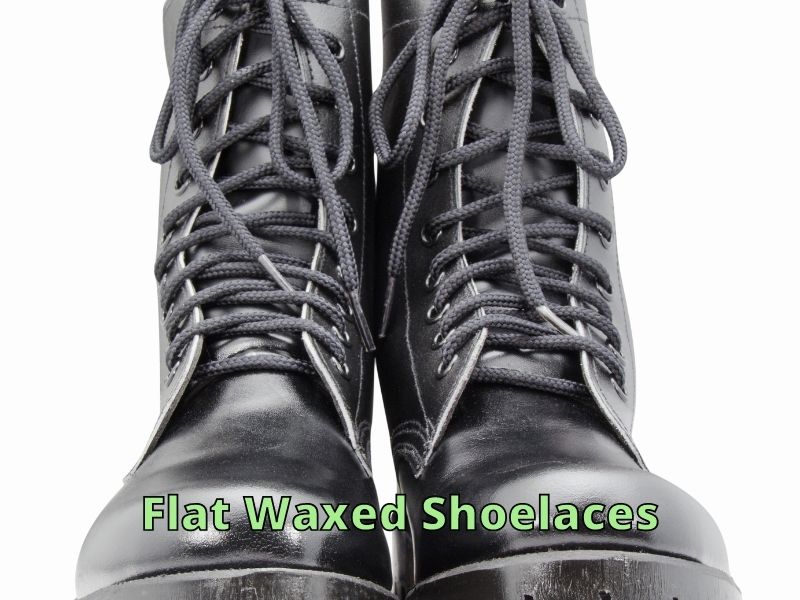
Flat waxed shoelaces are quite popular. While the wax on the laces may leave some residue on your hands when you tie them, it makes them more durable.
If you use regular flat cotton laces with heavy-duty boots, they might not hold up. Whereas flat waxed laces are strong enough to withstand any condition. The waxing on laces provides an extra level of strength.
You may find your laces brittle while tying and untying them due to the waxing, but they still perform well.
Flat waxed laces are mostly paired with service boots. The purpose of service boots is to protect your feet from the most rigorous conditions; however, the flat waxed laces are great to accompany them.
Nylon Shoelaces
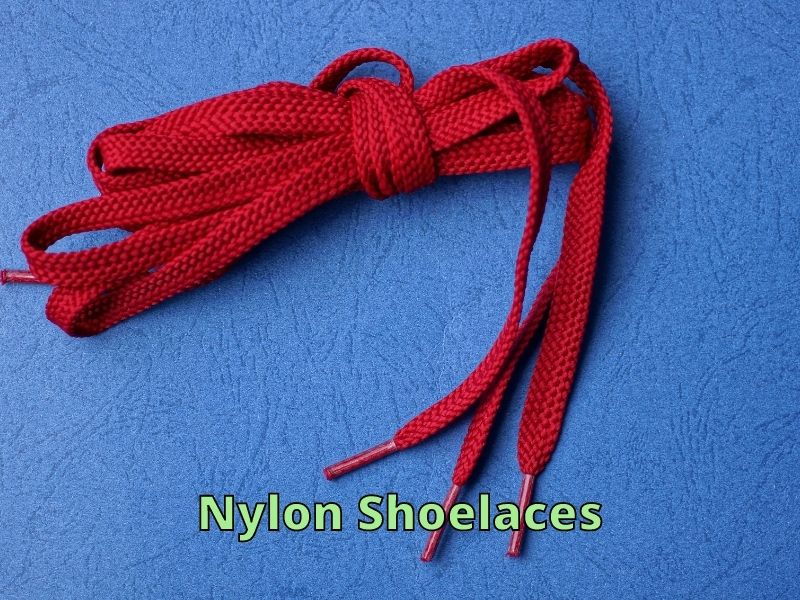
As nylon is a strong and durable material, nylon shoelaces are mainly used with boots, often subject to harsh weather conditions. Therefore, you will often see nylon shoelaces paired with snow boots, hiking boots, and military boots.
The nylon shoelaces are typically thicker than other types of shoelaces. This makes them easier to lace up and less likely to tangle. So even if you have frozen fingers or gloves on, you will have no problem handling them.
Nylon is exceptionally water-resistant, making it a better choice than other shoelaces in wet conditions. Nylon shoelaces are an excellent option for outdoor shoes or hiking shoes. These shoelaces are ideal for you if you are into outdoor activities.
Even though nylon shoelaces are a bit more expensive than others, they are worth the investment.
Benefits
- Nylon laces are one of the most durable and long-lasting shoelaces available.
- Nylon shoelaces are water and dirt-resistant.
- These shoelaces are highly weather resistant.
- These shoelaces are tangle-resistant.
- Nylon shoelaces can withstand challenging and harsh conditions.
- These shoelaces neither stretch nor lose their shape.
- Nylon shoelaces can be used as replacement laces for rugby and football shoes.
Drawbacks
- Nylon shoelaces do not look as cool as other shoelaces.
- Nylon shoelaces are more expensive than other shoelaces.
- Nylon shoelaces are bulkier and stiffer, making them hard to insert into the eyelets of the shoes.
- These laces can’t easily slide through buckles as compared to other shoelaces.
- Sometimes they are hard to adjust in shoes.
- Nylon shoelaces can be used as replacement laces for rugby and football shoes.
Textured Polyester Shoelaces
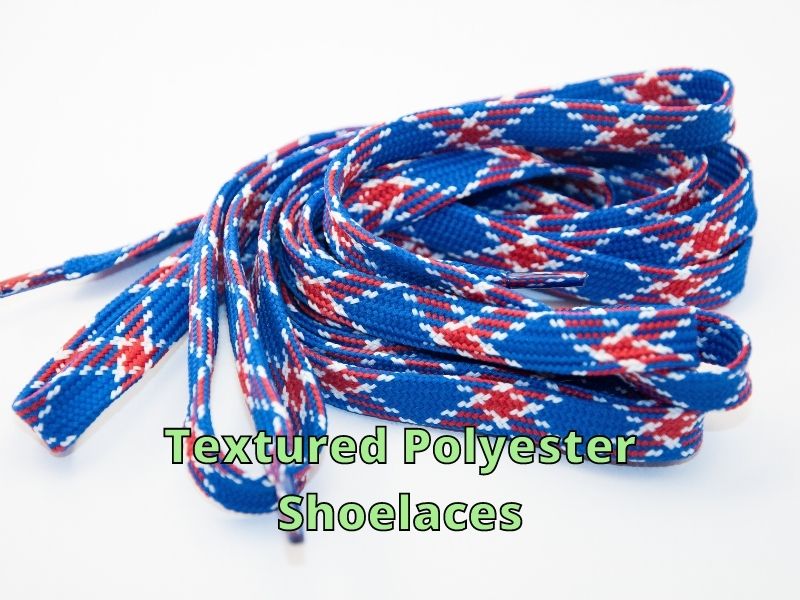
Textured polyester shoelaces are the most common type of laces in shoes. These shoelaces are made with light material and come in various lengths and widths.
Textured polyester shoelaces do not damage your shoes; however, they aren’t the most durable. The polyester material makes these shoelaces thick, so they do not get tangled easily.
You will see textured polyester shoelaces on work shoes and boots. These shoelaces also work well with skateboarding and ice-skating shoes because of their durability. You can also use them with your canvas shoes as they work pretty well with them.
Textured polyester shoelaces can be machine-washed but must be air-dried in a well-ventilated area to prevent them from frying. Properly cleaning and taking care of these laces can extend their lifespan.
Benefits
- Textured polyester shoelaces are more durable than cotton laces.
- These laces are water-resistant because of the polyester.
Drawbacks
- Textured polyester shoelaces tend to break easily.
- Textured polyester shoelaces are not available in many colors, so you will get only black or white laces.
Spun Polyester Shoelaces
Spun polyester shoelaces are similar to textured polyester shoelaces. However, they look more uniform and smoother than textured ones.
Spun polyester shoelaces are thin and are generally used with athletic shoes since they are non-stretch and flat. These laces are available in several colors and lengths.
Running with spun polyester shoelaces is smooth and comfortable since they hold their shape well. Also, these laces do not cause any blisters while you walk.
Unlike other shoelace types, spun polyester shoelaces will not have cords. Spun polyester shoelaces are fairly durable and have good resistance to sun damage.
Benefits
- Spun polyester shoelaces are pretty strong.
- These shoelaces are more durable than many other shoelaces.
- These laces have resistance to sun damage.
- You can get these laces in different colors.
- Spun polyester shoelaces hold their shape well and do not cause blisters when walking.
Drawbacks
- Spun polyester shoelaces do not look as good as other shoelaces.
- Over time, these shoelaces can become grubby.
Elastic Shoelaces
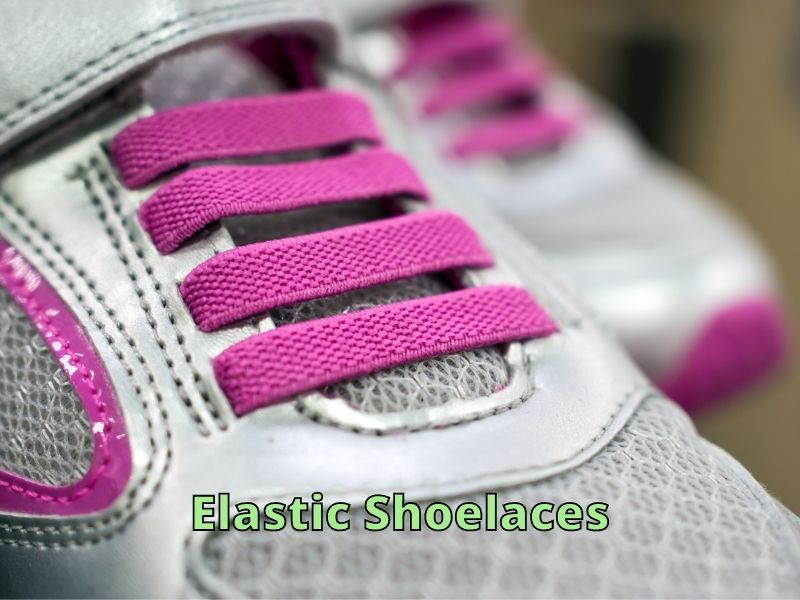
Elastic shoelaces are quite new and are among the latest shoelace models. These shoelaces are thinner than regular laces and have curved springs at the ends.
Elastic shoelaces are also called locked laces because when you lace up your shoes with these laces and tie them, the springs in the shoelace tips help the laces stay in place. That is why the shoe retains its knot.
Elastic shoelaces are also called no tie shoelaces since they transform your laced shoes into slip-on shoes.
You can use elastic shoelaces to make your shoes the best no-tie shoes. These shoelaces are attached to the eyelets of the shoes to make them slip on. They make it easy to slip in your shoes without adjusting the laces.
With elastic shoelaces, you do not have to lace up your shoes repeatedly. Instead, they can be slipped on and off without changing the lacing.
Elastic shoelaces are primarily used in sports, casual, running, and children’s shoes.
Benefits
- Elastic shoelaces allow transforming your laced shoes into slip-on shoes.
- These shoelaces make it easier to slip shoes on and off
- Elastic shoelaces eliminate the hassle of tying and untying shoelaces.
- These shoelaces offer a snugger fit and distribute lace tension.
- Elastic shoelaces are easier to maintain.
Drawbacks
- Elastic shoelaces tend to stretch in hot temperatures.
- During manufacturing, these shoelaces are mixed with other laces, thus making them difficult to use in some shoes.
- Their lifespan is not very long.
Paracord Shoelaces
You may not be familiar with paracord shoelaces since they aren’t trendy. However, Paracord shoelaces offer all the advantages of nylon laces but with more strength.
Paracord shoelaces are water and mold-resistant. The inner core of paracord laces is solid, so they will keep your shoes tied no matter what. These shoelaces can become your favorite and forever laces.
Types Of Shoelaces People Pair With Their Shoes
The following table gives an overview of which type of shoelaces generally work well with different types of shoes.
| Types Of Shoelaces | Paired With Shoes |
|---|---|
| Rawhide Shoelaces | Boat shoes Moccasins |
| Flat Cotton Shoelaces | Tennis shoes Fashion shoes Skater shoes |
| Round Cotton Shoelaces | Dress shoes Leather shoes Oxfords Derbies |
| Flat Waxed Shoelaces | Service boots |
| Nylon Shoelaces | Walking boots Snow boots Hiking boots Military boots Outdoor shoes |
| Textured Polyester Shoelaces | Work shoes and boots Skateboarding and Ice-skating shoes Canvas shoes |
| Spun Polyester Shoelaces | Athletic shoes Running shoes Smart shoes |
| Elastic Shoelaces | Sports shoes Casual shoes Running shoes Children’s shoes |
| Paracord | Hiking Shoes Outdoor Boots Skate Shoes Casual Tennis Shoes |
Difference Between Waxed and Unwaxed Shoelaces
Shoelaces can either be waxed or unwaxed. Let’s see the difference between the two.
| Waxed Shoelaces | Unwaxed Shoelaces |
|---|---|
| Waxed shoelaces are coated with either natural wax or paraffin wax. | Unwaxed shoelaces are typical regular shoelaces without any coating. |
| Waxed shoelaces are waterproof and long-lasting since they are protected by wax. | Unwaxed shoelaces are not waterproof and don’t last long. |
| You can adjust waxed shoelaces to make some areas lose and some tight. | It is harder to get unwaxed shoelaces tight. You have to re-tie them every half an hour. |
| Waxed shoelaces stay in place and tied for longer. | Unwaxed shoelaces do not provide a secure knot. |
| Waxed shoelaces can easily pass through eyelets, making them easier to tie and grip. | Unwaxed shoelaces are more difficult to grip and stretch when tying. |
| Waxed shoelaces do not slip. | Unwaxed shoelaces always slide. |
| Waxed shoelaces are rough on the hands. | Unwaxed shoelaces are soft on the hands. |
| The wax coating can quickly come off. | No wax coating. |
| Waxed shoelaces are difficult to untie. | The knot can be easily undone. |
| Waxed shoelaces are expensive. | Unwaxed shoelaces are inexpensive. |
Thanks for visiting helpshoe.com
References
shoeinfluence.com (Update: Website not reachable)

